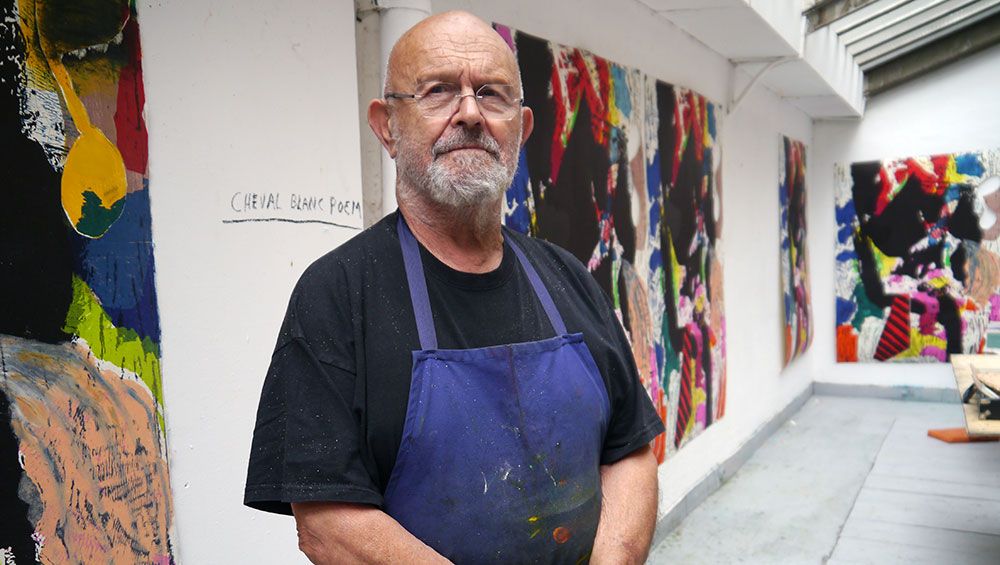
Jim Dine. © the artist.
by ANNA McNAY
At 85, Jim Dine (b1935, Cincinnati, Ohio) has a six-decade-long career under his belt, including nearly 300 solo shows. With a practice spanning painting, sculpture and poetry, he works uninterruptedly, and with as much dedication now as ever. His exhibition A Day Longer, at Galerie Templon, Paris, showcases works made over the past three years, many finished during the first lockdown. It includes a new body of self-portraiture, alongside bronze sculptures, and his easily recognisable paintings, into which he embeds tools and incorporates symbols from his personal iconography, such as hearts, skulls, veins and the comic character Pinocchio. The title of the exhibition, taken from one of his poems, is also the title of a newly published book of his poetry.
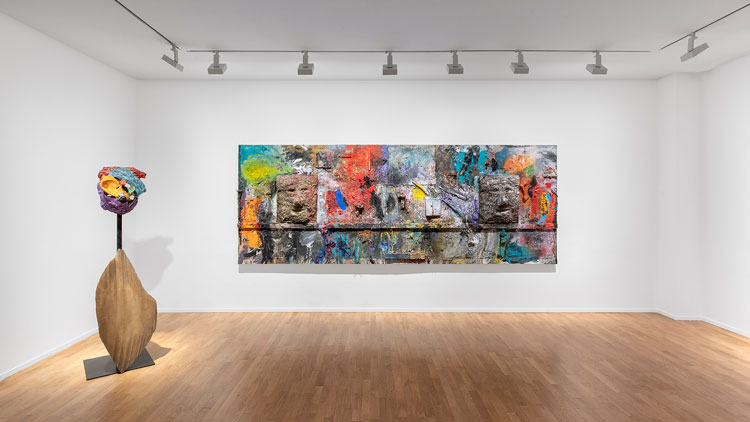
Jim Dine: A Day Longer, installation view, Galerie Templon, Paris. Photo: Nicolas Brasseur.
Dine spoke to Studio International from his Parisian studio via Zoom.
Anna McNay: You first gained recognition as one of the pioneers of the New York happenings in the 1950s, before becoming a key figure in the pop art of the 60s. For you now, how important was your involvement with these movements? What, if any, are the key aesthetics or ideas that carry through to your work today?
Jim Dine: Well, it was 60 years ago. I’m still standing, so I guess it has carried on in my work today.
AMc: Can you talk a little about the role of improvisation – a key feature of the happenings – in particular in your recent sculptures included in the exhibition?
JD: It’s how I create. I mean, it’s what I do. I improvise. It’s not like there’s a set formula. I try things and, if they work, fine, and if they don’t, then I go on to something else. I guess that’s improvisation.
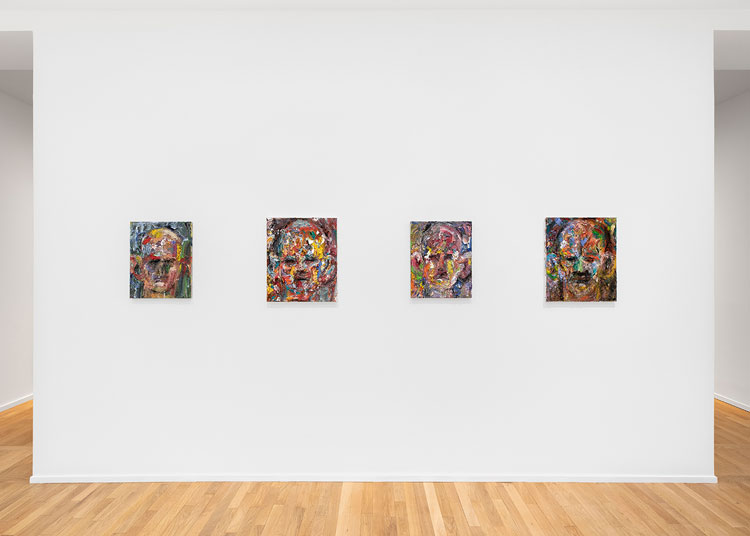
Jim Dine: A Day Longer, installation view, Galerie Templon, Paris. Photo: Nicolas Brasseur.
AMc: You have described yourself as being a “romantic expressionist”. Can you explain what you mean by that?
JD: When did I describe myself as that? A long time ago, I think.
AMc: Would you not use that term any more?
JD: Well, I don’t know. What the hell is the difference? It’s the work that counts.
AMc: Absolutely. Would you rather avoid labels?
JD: Probably.
AMc: You speak a lot about passion in relation to your practice. Is this your driving force?
JD: What’s the driving force in the things I do? You mean why do I keep on persisting? Because I’m standing, that’s why. That’s what I’m here for.
AMc: You feel you couldn’t possibly do anything apart from make art?
JD: That is correct.
AMc: You work across a huge number of mediums and incorporate different things into your work, both your sculptures and your paintings, plus you also write poetry. Are all of these mediums equally important to you?
JD: They are all important to me, otherwise I wouldn’t do them. And they feed one other, because I feel like it’s in my body. It is a stream of creativity. That’s what I do. That’s what I’m here for.
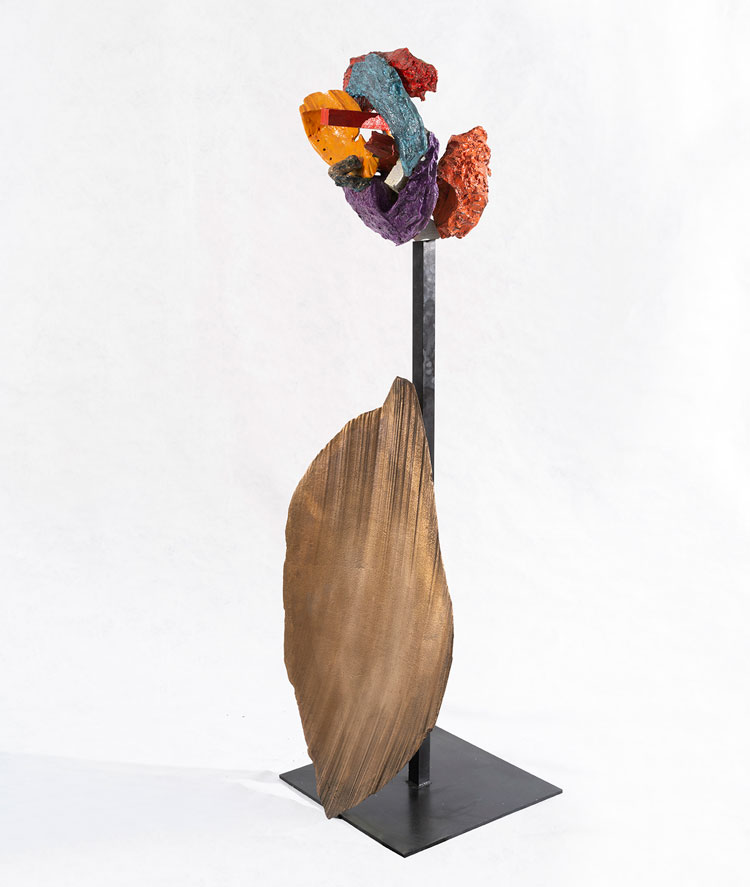
Jim Dine. At Dunkerque Version 2 Unique State, 2020. Bronze (unique cast at Bocquel's), 154 x 59 x 57 cm (60 5/8 x 23 2/8 x 22 1/2 in). Image © Courtesy Templon, Paris – Brussels.
AMc: You have been writing poetry since the 60s, despite being dyslexic. You also recently published a book of poetry with the same title as this exhibition, A Day Longer. How does your poetry relate to your visual artwork?
JD: It’s all me. That’s how it relates. It’s a voice instead of an eye.
AMc: We touched on process a little when you were talking about improvisation. Can you say a bit more about the process of making one of your works? Do you make models, maquettes, or sketches?
JD: No, I never make studies. I just begin. And then the work could take three or four years. But I just begin. It’s like jumping in the lake. And then I correct.
AMc: How do you correct?
JD: With my hands.
AMc: You do not know, when you set out, what you want something to look like when it is finished?
JD: I have no idea sometimes what the journey will be, but I’m confident that it will continue until it doesn’t.
AMc: And if you do not like something, then you just work over it, change it?
JD: I keep working on it. I keep correcting. I keep erasing. That’s my method. I keep judging it. I keep looking, and I keep tearing up and trying other things and trying to sleep and trying to live with myself.
AMc: Is that the same across the board – for your sculpture, painting and writing?
JD: For life.
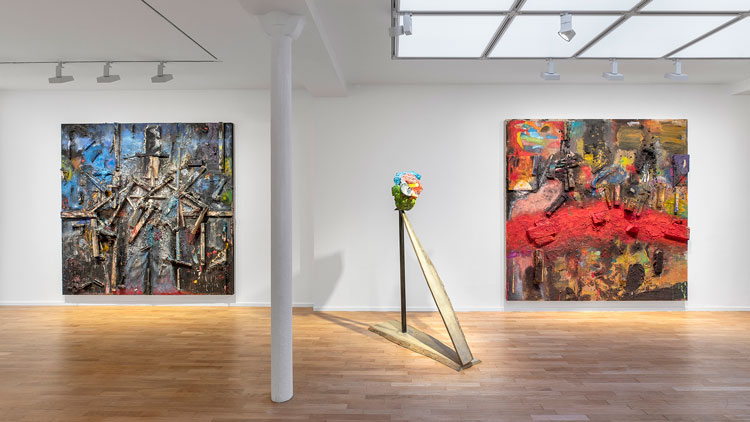
Jim Dine: A Day Longer, installation view, Galerie Templon, Paris. Photo: Nicolas Brasseur.
AMc: When you are working with bronze, do you go to the foundry yourself?
JD: I’ve made a lot of bronze. I’m very conversant with the process and have lived and worked with the foundry for 50 years. I don’t pour the bronze, because I’m not as good as the guy who pours the bronze, but I supervise everything.
AMc: By the point at which the bronze is being poured, you must know that you are happy with the work, as that is then quite a commitment.
JD: Exactly. It’s not something you can erase. It’s bronze. You can’t fuck around. You know what I mean?
AMc: Even so, you do then work on top of your bronzes, with paint and so on.
JD: Yes, I guess.
AMc: But it is more of a commitment than perhaps with a painting?
JD: Yes, I guess so.
AMc: You have mentioned working at the foundry. Do you have a large team working with you in your studio as well?
JD: I have the same people working with me all the time. I have three or four people who are trusted colleagues, and we share the act of working. I’m lucky to have colleagues like that, who understand what I need.
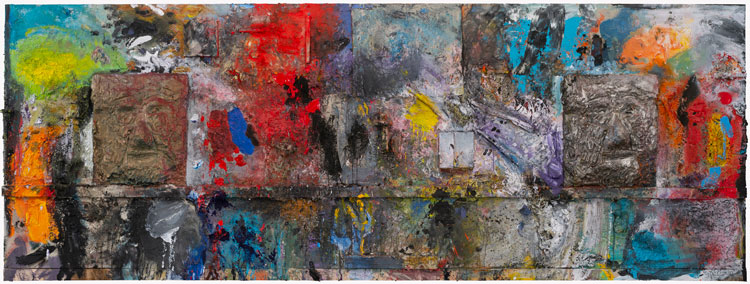
Jim Dine. Forgotten Harvest, Fragrant Spirit, 2020. Oil and acrylic on linen with bronze and aluminium heads incrusted, 161 x 430 x 21 cm (63 3/8 x 169 2/8 x 8 2/8 in). Image © Courtesy Templon, Paris – Brussels.
AMc: You have studios in Paris and Germany and on the west coast of the US. How do you – when not dealing with a global pandemic – split your time?
JD: I split it according to the work. If I have to be in the foundry, I will be in a foundry in Oregon. If I’m making books, I’m in Germany in my studio in Göttingen. It’s all about work and where the most efficient place is to be to get it done.
AMc: Is the work you make in one place different from that made in another, then?
JD: Well, it’s the same guy.
AMc: Obviously. What I mean is, are you influenced by the different cultures and surroundings?
JD: Not necessarily. I carry it with me, really, on my back.
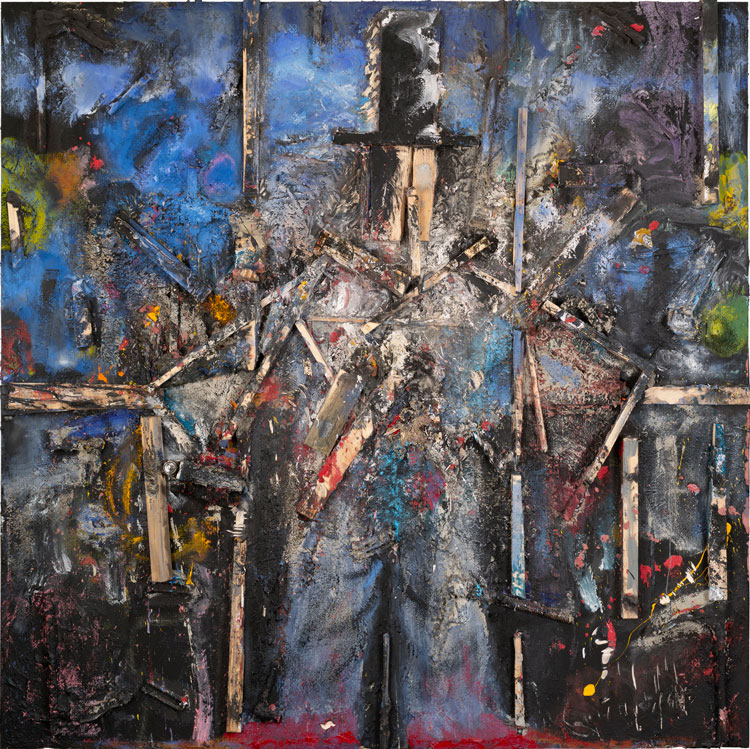
Jim Dine. Prophet in the Storm, 2020. Oil, acrylic and wood on panel, 246 x 246 x 19 cm (96 7/8 x 96 7/8 x 7 1/2 in). Image © Courtesy Templon, Paris – Brussels.
AMc: Your works come across as incredibly physical and full of energy. Has this side of them increased as you have journeyed through your life, or, at 85, are there things you now find you can no longer, or not as easily, do?
JD: I’m aware of human frailty. I’m aware of the organism, what it can do. But I know a lot more than I used to, so it’s a trade-off.
AMc: Absolutely. Am I right that most of the work for this exhibition was made during the first lockdown?
JD: It was finished during the lockdown, and, really, the lockdown gave me a lot of chance to concentrate more on individual work and to be working all day, every day, without any distraction. I don’t usually have much distraction anyway, but it was a wonderful time, a quiet time, and a valuable time for me.
AMc: You were obviously able to get to your studio, then?
JD: I slept in the studio.
AMc: Goodness. That is commitment! Did the lockdown feed into the ideas for any of the works, or did it change how you work?
JD: You mean has the pandemic given me subject matter? No. I just want it to be over.
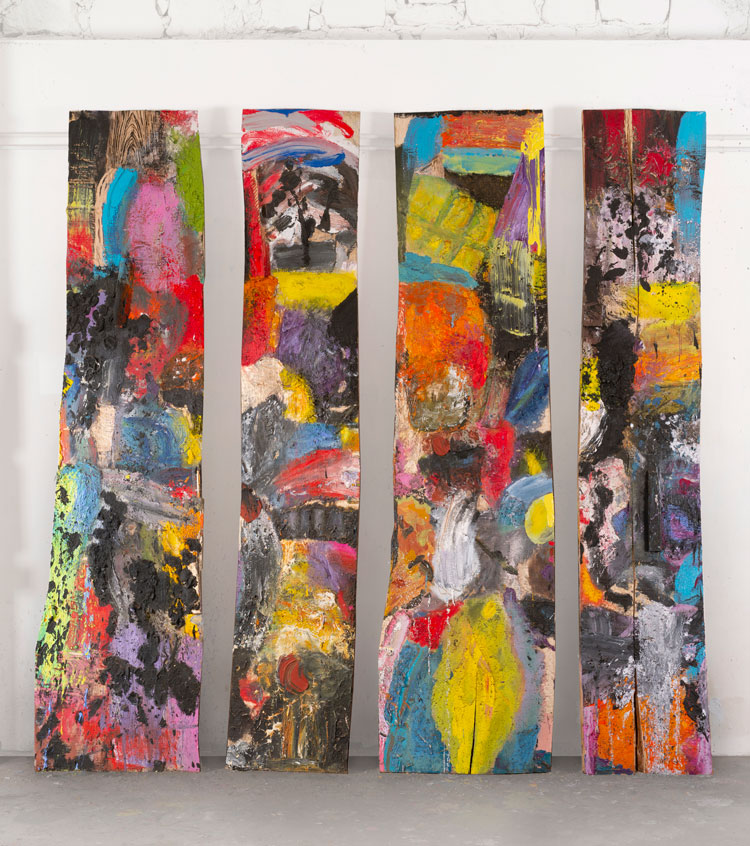
Jim Dine. Rules of the Forest, 2020. Oil and acrylic on lime and ash tress slates panel, 283 x 288 cm (111 3/8 x 113 3/8 in).
AMc: I think everyone does. Can we talk about the significance of some of the things – the tools, for example – that you incorporate into your paintings? I know your grandfather owned a hardware store.
JD: My whole life has been spent with them. I feel as if they are exactly the same as a tube of red paint. They’re something to be used, and, if it’s appropriate, I use them.
AMc: What about Pinocchio? Where does your use of him stem from?
JD: He’s been with me my whole life, too. I saw the movie when I was five or six years old, so he has walked with me my whole life. It didn’t just come about. It’s a story that is very meaningful to an artist, since it’s about the alchemy of something. It’s turning shit into gold. This is the talking stick that became a boy, an innocent metaphor for art.
AMc: You have other symbols in your personal iconography, as well, including hearts, skulls and veins. Do they all carry a fixed meaning, or does it change, depending on the context and how you put them together?
JD: Something like that.
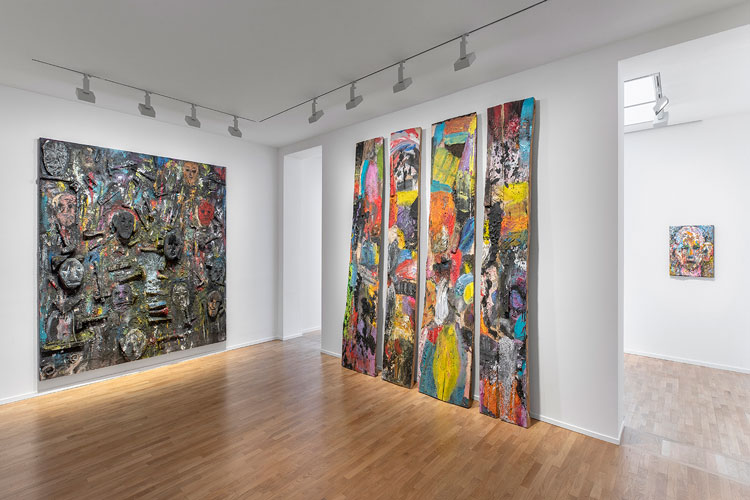
Jim Dine: A Day Longer, installation view, Galerie Templon, Paris. Photo: Nicolas Brasseur.
AMc: You are a very hard man to pin down, but I like that! In fact, it fits with my next question, which is about the fact that you have spoken about feeling the need to complicate your paintings. Can you say a little more about this?
JD: I’ve spoken of the need to complicate my paintings?
AMc: Yes.
JD: What do you mean?
AMc: I don’t know. That is what I was hoping you would explain.
JD: What did I say?
AMc: Just that you feel the need to complicate your paintings.
JD: No, I think maybe you misunderstood. I don’t recall saying that. I don’t try to complicate my paintings. It’s a complicated process already, this thing of trying to make art. I don’t try to simplify it. I just try to let it be. Let it exist. Let it happen. And when it works, it works. Sometimes it doesn’t.
AMc: How often would you say you give up on a piece?
JD: Give up on a piece? Never. No, I never have. I have never thrown anything out. I insist. I insist that it work.
AMc: You just keep adding and correcting?
JD: Correcting, yes.
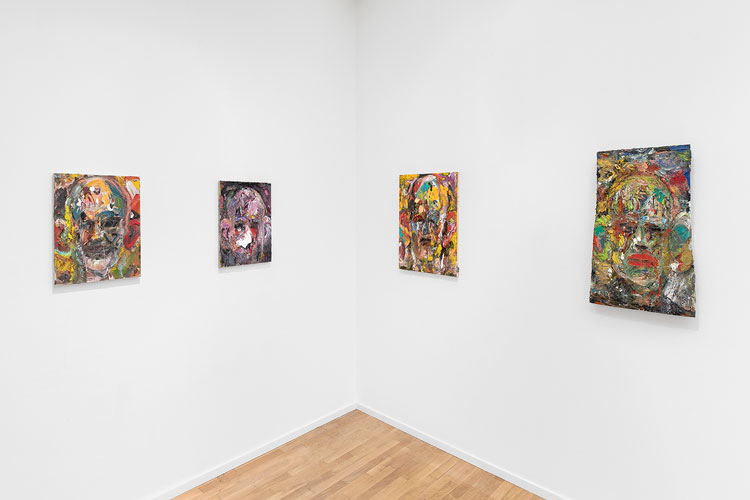
Jim Dine: A Day Longer, installation view, Galerie Templon, Paris. Photo: Nicolas Brasseur.
AMc: What is it that spurs you on? You said that making art is what you have to do. Are there particular themes, ideas or concepts that preoccupy you in your work? Is it that you are feeling something, and you want to express that emotion? Or do you have a message? What is your starting point for a new work?
JD: That’s taking the act of making something and trying to be specific with it. It doesn’t happen like that. I’m here as an artist to do my job, and I do that every day, period.
AMc: How do you know what to do for that first action though?
JD: Listen, I am 85 years old. I know.
AMc: And you are not going to share the secret?
JD: There is no secret. I go about my business. It’s what I’m here for.
AMc: What about the self-portraits?
JD: What about them?
AMc: They have been a key part of your practice for a long time. What are you looking for in them, or are you purely experimenting?
JD: I am the most willing model I have. I don’t like to waste the resource.
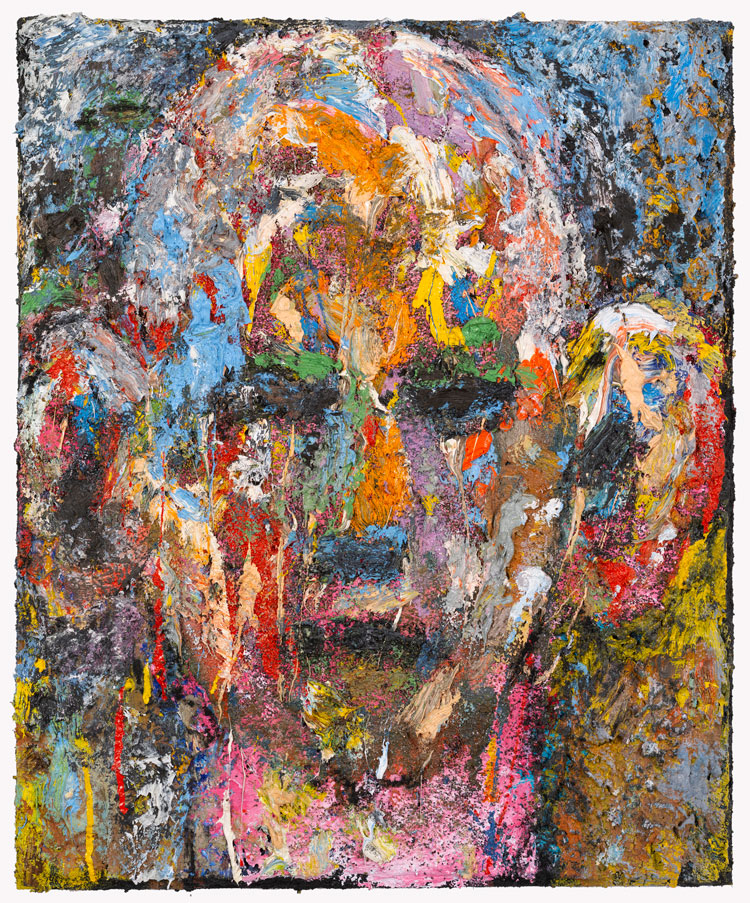
Jim Dine. Me #1, 2020. Oil on linen, 65 x 54 cm (25.5 x 21. 25 in). Image © Courtesy Templon, Paris – Brussels.
AMc: Do you look at yourself while you are painting them, or do you know yourself well enough now that you can just ad lib?
JD: I never stop looking. I never stop examining. I never stop inventing from what I see.
AMc: Is it true that you have been bald since you were 18?
JD: Since I was 18? Oh, yes. It’s me. I wouldn’t know what to do with hair.
AMc: You have probably saved a lot of money on shampoo.
JD: And on combs.
AMc: Definitely. Over what timeframe were the self-portraits in this exhibition produced?
JD: The last year.
AMc: There are quite a few of them.
JD: I think there are 15.
AMc: Is there a linear progression to them? Are they designed to be seen in any specific order? Do they tell a narrative of that timeframe?
JD: There is no narrative. There is observation, and there is what you get when you go about trying to do that.
AMc: The self-portraits, as well as your paintings more generally, not only use a lot of different materials, but are also painted on different surfaces – sometimes board, sometimes wood, sometimes linen.
JD: What does that have to do with anything?
AMc: I don’t know. Does it have anything to do with anything?
JD: I don’t know. It has nothing to do with anything. The point is what you get at the end.
AMc: But surely the surface you are working on affects how the process plays out, and therefore how the work turns out?
JD: Yes, it affects how it ends up looking, I guess. But do you really think that’s relevant? I think what is important is what it looks like at the end, whether it was made with my eyes closed or with my finger.
AMc: Do you ever work with your eyes closed?
JD: No.
AMc: No, because you said you never stop looking.
JD: Yes.
AMc: Obviously, with the self-portraits you are looking at yourself. When you are making your other works, what are you looking at then? Are you looking at the work itself as it develops?
JD: No, I trust in my hand.
AMc: Where does your colour palette derive from?
JD: From my eyes and my hand. From the knowledge that I have gained over the years. From what I choose to use. It doesn’t derive from anywhere else except from the hand that holds the colour.
AMc: How involved were you with the selection of works for this exhibition?
JD: How involved was I? I made them.
AMc: Yes, I mean with the selection for the exhibition, though?
JD: It is what I have made over the past three years.
AMc: You mean the exhibition comprises basically everything you have made in that period?
JD: That’s it, yes.
AMc: Was the title of the exhibition, A Day Longer, your choice?
JD: That’s right.
AMc: Where does it come from?
JD: It’s from a poem I made.
AMc: It is also the title of the book of poetry you have just had published. What do you want people to understand by it?
JD: It’s just a day longer, one hopes.
AMc: Do the titles of your artworks also come from your poetry sometimes?
JD: Yes.
AMc: Always, or just sometimes?
JD: Always.
AMc: But it is not necessarily the case that you have a poem in mind and then create a work which relates specifically to it?
JD: No. I find the line that is appropriate.
AMc: After the work is made?
JD: Hopefully.
AMc: Does that sometimes take a while? Is there sometimes a work sitting there waiting to be named?
JD: Exactly. I don’t start off with a title. The title comes at the end. It’s not about the title, never. It’s never a case of: “This is what it’s about.” The title is another element, in a way – like using a particular colour. The title is just another element.
AMc: How often do you write poetry?
JD: Poetry comes to me every day, and I work at it every day. I have notebooks full of it.
AMc: Do you have a specific time when you write your poetry?
JD: No.
AMc: So, you might be in the middle of working on something in the studio when it comes to you?
JD: I don’t think it would be like that, nor does it make any difference what my method is. The point is, it exists, or it doesn’t exist. You are inspired by it, or you’re not. You think it’s crap, and it’s up to you.
AMc: You are currently in the middle of the second lockdown. Are you sleeping in your studio again?
JD: Yes, sort of. It’s the same kind of life as always. I go to work. I go home. I read. I write. I go to sleep. Unless you get the dreaded Covid, one’s life is pretty much the same. Except it’s tough to go to a restaurant. But I don’t care. I cook better at home.
AMc: Now that this exhibition is installed, are you just carrying on making more work?
JD: Yes.
AMc: That is just what you do.
JD: That’s just what I do. I’m working. I’m working on new things, new ideas.
• Jim Dine: A Day Longer is at Galerie Templon, Paris, until 23 January 2021. Gallery viewing room.
Click on the pictures below to enlarge